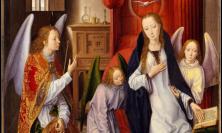A very ordinary painting prompts an Oxford philosopher to think about the extraordinary feast that we observe on 25 March. When we contemplate the Annunciation, are we trying to understand, to penetrate, to grasp the transcendent mystery beneath what, on the surface, is very ordinary; or to recover a sense of the very ordinariness of the events which bore so much theological weight?
At the top of a staircase in Campion Hall, the Jesuit-run private hall in the University of Oxford, there hangs a quiet, unremarkable painting, done sometime in the 1990s. It depicts a rather bare room, in which there is seated a woman with a man standing next to her. Both figures are very formal; the woman sits with her hands in her lap, looking straight ahead and downwards towards the floor. She is wearing a dark dress, the man a loose shirt and grey trousers. He is standing sideways on to the woman, looking at her from the side, with his outstretched hand on her shoulder. I have asked many people what they think it depicts and the usual response is puzzlement; they can see nothing in the picture on the basis of which they would say any more than ‘It’s a man meeting a woman.’ In fact, the subject of the painting is the Annunciation of the Blessed Virgin Mary.
Once you have been told that, all kinds of details then leap out of the canvas. The woman’s dress is dark blue – a traditional Marian colour; and while the man is painted in shades of grey, still, in the context of the painting, these cool shades have a translucent, almost ethereal quality, as befits an angel. Her pose is not just pensive, it is almost troubled; and his gesture is not really one of greeting, but rather an expression of reassurance. The painting, which would be quite unremarkable as a portrait of two people, is striking indeed as a commentary on the Annunciation.
It is a remarkable commentary precisely because what is on the canvas is, in itself, unremarkable. How sharp a contrast there is between this depiction of quintessential ordinariness and the meeting between majesty and sweet humility so characteristic of the classical paintings of the same subject. Classical angels are majestic, with the kind of beauty which radiates power; the Spirit of God enters the room more brightly than any sunbeam; the Virgin, for all her lowliness of demeanour, is shown as lovely, prayerful, trusting, usually delighted. There are, then, two very different points of view from which one can contemplate the Annunciation. From one angle, the aim is to understand, to penetrate, to grasp the transcendent mystery beneath what, on the surface, is very ordinary. From the other point of view, the aim is to recover a sense of the very ordinariness of the events which bore so much theological weight.
On most of the occasions on which Luke mentions Mary he takes the former approach; he is intent upon helping his reader to appreciate the cosmic importance of what is happening. The focus of his account of the Annunciation is primarily on who this baby really is. He is Son of the Most High, the heir to the throne of David, Son of God, conceived by the overshadowing of God’s powerful presence. Luke’s words are meant to remind us of the spirit of God hovering over the waters of creation; and he will remind us of this again when he relates how the Spirit came upon Mary and the apostles at Pentecost. In many places in the Acts of the Apostles, Luke suggests that the Christian community relives the life of Jesus; so Mary is present at the birth of the community as she was at the birth of Jesus. Again, when Mary visits her cousin Elizabeth, this is no mere act of cousinly concern. Under the inspiration of the spirit of God, Elizabeth and her as yet unborn child recognise Mary as the mother-to-be of the saviour, and Mary responds by praising God for Jesus, just as Zechariah does for John the Baptist, for God is coming to redeem his people. In the same way, the birth of an otherwise obscure child is ringed by a chorus of angels; and a circle of shepherds, the anawim, the simple poor of Luke’s Gospel, are the first to worship him in wonder. Yet again, the routine presentation of a recently born child in the Temple is fraught with deeper significance. Luke makes sure that Simeon and Anna are, dramatically speaking, led by the Spirit of God to the Temple so that what is hidden from ordinary eyes is clear to the reader. This child is the instrument of the salvation for which Simeon and the whole people have been waiting, a revelation to the Gentiles, and glory for the people of Israel. The child is also one who brings not peace, as Jesus himself was later to say, but the sword of scandal and division.
In many ways, then, the early chapters of Luke’s Gospel are similar in intent to the classical paintings of the Annunciation and of the other episodes in the childhood of Jesus. In those paintings Mary appears as no ordinary woman; the child is no ordinary child; and every artistic symbol is used to make sure that the beholder grasps the many levels of meaning implicit in what is depicted. Sometimes, pictures of the Annunciation or the birth of Jesus will even have a cross tucked away in the distance, almost out of sight, just as Simeon’s prophecy strikes a sombre note in the midst of all the tuneful celebrations of the Lucan angels. That is one angle on the Annunciation. But, as I have said, there is another point of view to be explored.
On the Feast of the Purification in 1843, John Henry Newman preached a sermon for which he took as his text, ‘But Mary kept all these things and pondered them in her heart’, which Luke uses twice within a few lines to emphasise that sense of pregnant meaning which pervades the two opening chapters of his Gospel.[1] Newman’s opening sentence is exact. ‘Little is told us in Scripture concerning the Blessed Virgin, but there is one grace of which the Evangelists make her the pattern in a few simple sentences – of Faith.’[2] There follows what is in effect a first draft of Newman’s famous ‘Essay on The Development of Christian Doctrine.’
Newman’s opening sentence is exact in three ways. First, there is much already-developed doctrine in these Lucan narratives about the infant Jesus and his mother. Secondly, indeed very little is told to us in Scripture concerning the Blessed Virgin. And thirdly, thinking about Mary as she appears from the texts can help us to understand our own call to faith. I would like to try to develop these three themes.
I know it is commonplace for clerics to bemoan the secularisation of Christmas and to lament the consequent lack of attention paid to the events of the first Christmas. But there is a case to be made for almost an opposite view, at least so far as practising Christians are concerned, and perhaps also for those whose Christianity is at best nominal. We are all familiar with what one might loosely call ‘the Christmas story’. In Newman’s terms, this story, even as it appears in Luke and Matthew, is already highly developed doctrine; and over the subsequent centuries it has been further embellished with the delightful details of popular piety. All this is such an acquired part of the Christmas scene, in card, carol and crib, that we can only sometimes, and then only with the greatest difficulty, distinguish fact from theology, event from interpretation. Even the more obvious trick questions can catch people out, in that the gospels nowhere mention snow, stable, ox or ass; shepherds do not bring gifts of lambs; there are no kings, and camels are definitely out. The theological meaning has become so much part of our unreflecting consciousness that it is very hard indeed for us to recover any sense of the ordinariness of the events which Luke and Matthew make such efforts to illuminate. As a result, we tend to underestimate the immensity of the act of faith which governs these early chapters of the gospels. We develop a quite mistaken view of what it is in Mary that we might learn from and try to practise in our own lives. Developed doctrine becomes the enemy of reflective discipleship.
Newman is right on the second point as well. The scriptures do indeed tell us very little about the Blessed Virgin. Of course, as we have just recalled, they tell us a great deal about her significance, but remarkably little about her. Even that very little is not easy to recover, since none of the gospel writers, nor the traditions upon which they drew, was especially concerned with the unvarnished facts of her life, still less with her inmost thoughts and hopes and fears. That is one reason why I like the painting of the Annunciation in Campion Hall. It shocks me into reminding myself of the ordinariness of what happened. The casual observer does not see in that painting an Annunciation at all, but an unremarkable picture of two people in a bare room. Of course a gospel is not a purely theological treatise: it develops its theological teaching by reflecting on history, on the events of the life of Jesus and those around him. But those events are not easy to detach from the theological interpretation which has been put upon them. So it is with Mary the mother of Jesus. She did give birth, she had her child circumcised, and she came to the Temple herself to go through the ceremony of purification as many another Jewish mother would have done. But what else do we know? The few further references there are to Mary in the synoptic gospels make for disturbing reading, for they suggest that she found her son at times difficult, and in the end almost impossible to understand.
Take Luke’s account of the finding of Jesus in the Temple. It certainly is not uninterpreted historical fact. It is presented as a symbol of things to come. I am thinking of the statement that Jesus was lost for three days before being found again, whereupon his parents were rebuked for not realising that he would have to be doing his Father’s business. I take this to be a deliberate reference forwards to the despair of the disciples until the third day after Jesus’s death, and their failure to understand how all that had happened was part of Jesus’s obedience to the Father. Luke has Jesus deliver a very similar rebuke to the two disciples on the road to Emmaus. But even if the three days of separation from his parents is historically implausible, it is surely quite possible that Jesus and his parents did become separated at least for a while on a visit to Jerusalem. And if it is true that this came about because Jesus deliberately stayed on in the Temple, that would be sufficient to suggest to Luke the deeper truth that this historical misunderstanding prefigures. His parents, the gospel says, ‘did not understand what he was saying to them.’ They grasped neither his explanations for staying behind, nor the deeper truth that his relationship to his Father in heaven could over-ride his relationship to Mary and Joseph.
The misunderstandings were to become more serious. In Mark’s Gospel we hear that, early in Jesus’s ministry, his mother and his brothers came to take him home, because they thought that he was out of his mind. (Mk 3:21, 31–35). Some Jerusalem scribes thought he was possessed by Beelzebul, and his family seems to have thought that he needed protection from them. This time, Jesus’s rebuke to Mary and the rest of the family was even sharper: when told that his mother and brothers were outside asking for him, he said ‘”Who are my mother and my brothers?” And looking around on those who sat about him, he said “Here are my mother and my brothers. Whoever does the will of God is my brother and sister and mother.”’ Luke tones the remark down a bit, but the Fourth Gospel reiterates the point that Jesus’s brothers simply did not believe in him. (Jn 7:5) As Jesus himself sadly reflected, ‘A prophet is never without honour except in his own country, among his own kin and in his own house.’ (Mk 6:4)
So Mary was not one of Jesus’s disciples. Indeed, apart from some texts where Jesus’s own ministry is called in question on the grounds that everyone knows how ordinary his parents were, Mary disappears altogether from the story of Jesus and his preaching. Except that in the Fourth Gospel, and only there, she appears at the foot of the cross on Calvary, where she is entrusted by the dying Jesus to the beloved disciple, ’Mother, behold your son: son behold your mother.’ Many commentators take the beloved disciple in this scene to stand for the typical Christian, and Mary to be in some sense named as the mother of all believers; if so, this scene would be parallel to Luke’s narrative in which Mary is present at the birth of the Church at Pentecost. So in the end, Mary was central to the community of believers. That is why she is presented in such glorious terms in the introduction to Luke, and her future importance hinted at by the Fourth Gospel in the description of her role at the feast of Cana, even though her son’s hour had not yet come. With hindsight, they ask us to look with wholly new eyes at that young Jewish woman, who continued to love her son but was not wholly convinced by him. We have no way of knowing what transformed her from a mother intent only upon saving her son from his own mistakes to a woman revered by the early community, whom all ages will henceforth call blessed. Yet some such transformation there surely must have been, or our texts would never have been written as they were.
Newman’s third remark about Mary is that she is presented as a paradigm of the gift of faith. So what can Mary teach us?
The ordinary, the mundane, the all too human, are both the locus of faith and the greatest obstacle to faith, because our world is shot through with sorrows. One key element in faith is to be able to read the world – the ordinary everyday world – as God’s world. I am not saying, for instance, that those who prosper in this world do so because God’s blessing is upon them, or that those who suffer must have sinned; Jesus himself gave the lie to the more naive versions of salvation history. Of the Galileans massacred by Pilate he said, ‘Do you think that these Galileans were worse sinners than all the other Galileans because they suffered thus? .... Or those eighteen upon whom the tower in Siloam fell and killed them, do you think they were worse offenders than all the others who dwelt in Jerusalem? I tell you, No; but unless you repent you will likewise perish.’ (Lk 13:2–5) I do not for one moment suggest that every event in our world is somehow planned by God, with its hidden meaning left there for us to discover and decipher. By the same token, we are not required to believe that God planned that his Son should be rejected and put to death. Still, if we are to be able to believe that a world in which such terrible things happen is nevertheless God’s world, then somehow we have to be able to find God in it. To paraphrase St Paul, even though our everyday life be afflicted by tribulation, distress, persecution, famine, nakedness, peril or the sword, nothing in heaven or on earth will be able to separate us from the love of God manifest in Christ Jesus (Rom 8:35–9). That earthy, rooted confidence has to be part of our experience. It has to make both intellectual and emotional sense to us, or our faith becomes irrelevant – a matter of abstract credal formulae or churchy habit, as nice and as disposable as a Christmas card. The locus of genuine, living, faith is the mundane, the routine of life, for better and for worse. And, as Jesus’s hearers, including Mary herself, so often found, the mundane and the ordinary can so easily be the greatest obstacle to faith. Who could readily believe that their son, or the young carpenter next door, is a prophet sent by God, let alone more than a prophet? Even if someone were inclined to think that unthinkable thought, who could readily sustain that belief in the face of strange, almost blasphemous, preaching, and a total rejection not merely by their religious authorities but, to all appearances, also by God?
So what makes faith emotionally and intellectually possible? I don’t suppose there is just one answer to that question which would precisely fit everyone. Some people are almost shocked into faith – by tragedy, or imminent threat, or by being forced to reflect on bereavement. A situation can present itself where the alternatives are so sharp; either faith or despair, insight or meaninglessness. Both responses are there, readily available. The world in all its harshness is both the locus and the obstacle. Some such sword surely pierced Mary’s heart, confronting her at the end with the starkest of choices. Perhaps more commonly, faith, genuine faith, becomes possible at the moment in which someone discovers that unbelief is a very possible alternative – when routine conformity is challenged by the necessity of genuine commitment.
Whatever the occasion, one lesson of which Mary should remind us is that faith is not possible without love. We are not disembodied minds, nor are human emotions irrational, non-cognitive feelings. They are interpretative responses to the world around us. Our feelings can, of course, distort our judgement, or distract us from even trying to form a reasoned assessment of what is happening in our lives. But equally, emotions can be a source of insight, a stimulus to our minds to see things more deeply, more discerningly. I have argued that we can glean from the gospel texts that Mary loved her son, despite the difficulties which that love forced her to deal with. Perhaps that very love was the root of her understanding. As the gospel text chosen by Newman puts it, in her heart she kept and pondered all these things. What, then, in our lives corresponds to the natural love of a mother for her child which illuminated the meaning of it all for Mary? Surely the answer to that has to be the practice of prayer. Prayer after all is love seeking understanding. Prayer in love seeks a grasp of God which is deeper than all our everyday words, beyond our best theological formulae. Yet faith and prayer interact. Faith informs and colours our prayer, and helps us when later we reflect on prayer, trying to interpret and understand it. But, I believe, it is prayer which makes faith possible, just as emotions can be a valuable source of insight into our earthly affairs. And what makes prayer possible? That too has different roots for different people, and different roots for any one of us at different times. Prayer can spring from tragedy and from delight; from music, from contrition, from sheer need, even from the beauty of someone else’s faith. I vividly recall an unremarkable sunny afternoon in what was then Southern Rhodesia. I was speaking to a young man who was studying to be a catechist in a rural mission. He told me that he thought that the freedom fighters who were then in the process of overthrowing the government would probably try to kill all the white priests, so catechists would be all the more needed. Moreover, he thought that if he proved to be effective as a catechist, he too would soon be killed, as Jesus was. This was said in such a matter-of-fact way; but I have never forgotten the prayerful grasp of the beauty of God’s gift of faith which I felt at that moment, unexpectedly, as I was making polite conversation walking across a scrubby garden.
If we will but listen, God can speak to us in many ways at the most ordinary times. Lent is a time for listening. The decorations of Christmas, the splendour of all those medieval depictions of the Annunciation, these are now behind us. The grey ordinariness of the Campion Hall Annunciation serves to remind us that we have to find God in all things, that we can find God in all things, however uninspiring or mundane or difficult. Yet again this Lent we need to learn that the key to a living faith is prayer, just as love for her son may have been what unlocked that faith for Mary. When, yet again, we have learned that truth, we can each in our own way rediscover with delight the presence of God which lurks hidden in our unremarkable worlds. Then, like Mary, in our hearts we too can respond to that presence and sing our personal Magnificat; ‘My soul doth magnify the Lord, and my spirit rejoices in God my Saviour.’
Gerard J. Hughes SJ is a tutor in philosophy at Campion Hall, University of Oxford. This article is adapted from a sermon delivered at Oriel College, University of Oxford, in March 2001.
[1]Lk 2:19, and 2:51
[2]Fifteen Sermons preached before the University of Oxford, Sermon XV.






